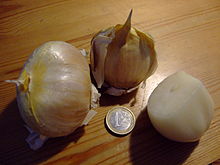Field onions
| Field onions | ||||||||||||
|---|---|---|---|---|---|---|---|---|---|---|---|---|

Field garlic, drawing by Walter Hood Fitch (1817-1892) ( Allium ampeloprasum ) |
||||||||||||
| Systematics | ||||||||||||
|
||||||||||||
| Scientific name | ||||||||||||
| Allium ampeloprasum | ||||||||||||
| L. |
The Allium Ampeloprasum ( Allium ampeloprasum ), also arable garlic or summer garlic called, is a plant from the genus allium ( Allium ). The natural range of the field leek extends over southern Europe, North Africa and the Middle East. Other occurrences in the British Isles could also belong to the natural range. It is used as spice - and medicinal plant uses. The pearl onion also belongs to this species .
description
The field onion grows as a strong, persistent , herbaceous plant with heights of up to 180 cm. At the bottom, the plant shows only a small amount of nodules, which is greatly enlarged in the cultivated form of the giant garlic. The two-row leaves have a V-shaped cross-section, are up to 50 cm long and their leaf sheaths form a pseudostem around the actual stem .
The flowering period is from June to August. The spherical, golden inflorescence has a diameter of 4 to 12 cm and usually has several hundred flowers. There are shapes that form bulbs in the inflorescences, then there are fewer flowers. There is a large bract . The hermaphroditic, radial symmetry , threefold flower is 4 to 5.5 mm in size. The two by three differently shaped, upright bracts are dark red, purple or white. The three outer and three inner stamens are designed differently. The anthers are purple or yellow. The scar is heady.
Egg-shaped capsule fruits are formed, which have a diameter of 2 to 4 mm. The black seeds are obovate.
The number of chromosomes is 2n = 32, less often 16, 24, 40, 48, 56 or 64.
use
Like other plants of the leek genus ( Allium ), the field onion can be used as a spice or medicinal plant due to its ingredients, whereby it is said to have a disinfecting and digestive effect. The taste or irritation of field garlic is milder than that of onion and garlic . Onions and leaves are eaten raw or cooked, the flowers can be eaten raw.
Medicinally, it is used like garlic. The sap is said to drive away insects and mice.
Systematics
Synonyms for Allium ampeloprasum L. nom. cons. are: Allium porrum L. , Allium kurrat Schweinf. , Allium porrum L. subsp. eu-ampeloprasum Breistr. , Allium scorodoprasum subsp. babingtonii (Borrer) Nyman .
Subspecies and varieties
- Allium ampeloprasum subsp. ampeloprasum var. babingtonii (Borrer) Syme
- Allium ampeloprasum subsp. ampeloprasum var. bulbiferum Syme
- Allium ampeloprasum subsp. ampeloprasum var. holmense ash. & Graebn.
Field garlic is considered to be the original form of the following crops:
- Leek or leek ( Allium ampeloprasum leek group, syn. Allium porrum L. , Allium ampeloprasum subsp. Ampeloprasum var. Porrum (L.) J. Gay ) is used as a vegetable, spice or salad.
- Pearl onions ( Allium ampeloprasum pearl onion group, syn .: Allium porrum var. Sectivum ) are mainly added in tins
- Elephant or giant garlic ( A. ampeloprasum giant garlic group), with bulbs weighing up to 60 g, is used as a garlic substitute, but has a much milder taste.
- Kurrat or Egyptian leek ( Allium ampeloprasum Kurrat group, syn .: Allium kurrat Schweinf. Ex K. Krause , Allium ampeloprasum var. Kurrat , Allium porrum var. Aegyptiacum Schweinf. ) Is eaten as a vegetable or salad.
Botanical history
Margaret Mezzabotta assumes that the field onion was known to the Romans under the name Ulpicum . It was used for food and medicinal purposes.
Field onion was described by Linnaeus in 1753 under the name Allium ampeloprasum , at the same time he called the leek Allium porrum . In 1779 Jean-Baptiste de Lamarck brought both species together under the name Allium porrum , so that this name was also valid for field onion . In the years that followed, a large number of subspecies and varieties were described; the Kew Gardens database lists 40 of them. These all go back to cultivated plants that show a wide variety of shapes. Because the name Allium ampeloprasum continued to be used frequently, it was proposed by Hanelt in 1996 as a “nomen conservandum”, ie as valid, although Lamarck had chosen Allium porrum as the name. Both names can be found in the literature.
swell
- Description in the Flora of North America. (engl.)
- PROTAbase data sheet for Allium ampeloprasum .
- P. Hanelt & IPK (Ed.): Mansfeld's Encyclopedia of Agricultural and Horticultural Crops , online version.
Individual evidence
- ↑ a b Entry in Flora Europaeae
- ^ Tropicos. [1]
- ↑ a b Entry in Plants for a Future. (engl.)
- ↑ Margaret R. Mezzabotta, What Was Ulpicum ? Classical Quarterly 50/1, 2000, 230-237. Stable URL: https://www.jstor.org/stable/1558947 . Accessed January 1, 2019
- ^ R. Govaerts: World Checklist of Allium Online


